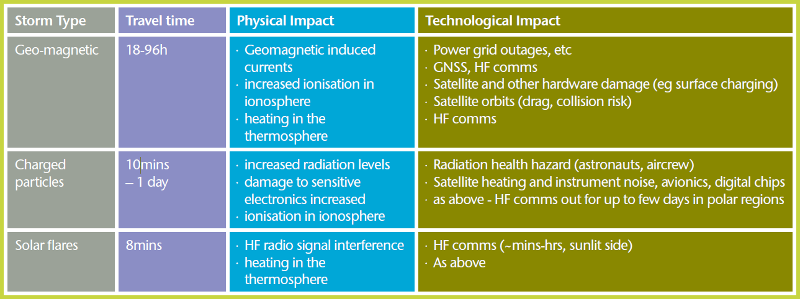What is space weather?
All you need to know about space weather and its impacts.
The most recognisable and visible space weather effect is arguably the auroras (Northern and Southern Lights). However, as well as these spectacular natural phenomena, space weather also represents a real threat and can have an impact upon national infrastructure, technology, and communications systems.
The threat of space weather to national infrastructure, UK industry and the wider public is such that in 2011 it was added to the Government National Risk Register of Civil Emergencies. In response, the Met Office Space Weather Operations Centre (MOSWOC) was created to provide the critical information needed to help protect the country from the serious threats posed by severe space weather events.
What causes space weather?
Space weather is a consequence of the behaviour of the Sun, the nature of Earth’s magnetic field and atmosphere, and our location in the solar system. The active elements of space weather are particles, electromagnetic energy and magnetic fields, rather than the more commonly known weather contributors of water, temperature and air. Magnetic fields, radiation, particles and matter which have been ejected from the Sun can interact with the Earth’s magnetic field and upper atmosphere to produce a variety of effects
Types of space weather event
Space weather conditions vary. Streams of particles from the Sun carried by the solar wind constantly hit the Earth. During periods of high solar activity, when there are more solar flares and coronal mass ejections (CMEs), Earth experiences increased impacts. Extreme events that cause the largest impacts can occur at any time during the 11 year solar cycle.
Coronal mass ejection/Solar flares
A CME is the ejection of material from the Sun into interplanetary space. If the material is directed towards the Earth then the event may result in a disturbance to the Earth's magnetic field and ionosphere.
Solar flares are the sudden releases of energy across the entire electromagnetic spectrum. They are hard to predict, and the energy can be detected in Earth's atmosphere as soon as 8.5 minutes after the occurrence of a solar flare.
CMEs are often associated with flares. They can take days to reach Earth, carrying a local magnetic field from the Sun, and their arrival time is the focus of space weather forecasting.
Radio blackouts
The ionosphere is a dynamic part of the upper atmosphere which acts as a reflector for long range, high frequency communications (HF comms). During a solar flare the increase in x-ray radiation from the Sun causes the ionosphere to absorb rather than reflect signals and this disrupts communications systems on the sun-lit side of the Earth. The Sun may also emit radio bursts at multiple wavelengths causing various problems for communication and navigation systems.
Even during periods of quiet solar activity turbulence in the ionosphere can result in a scattering of electromagnetic waves disrupting navigation systems like Global Navigation Satellite Systems (GNSS) often known as Global Positioning System (GPS) and radio bands up to the GHz frequencies. These are referred to as radio blackouts.






